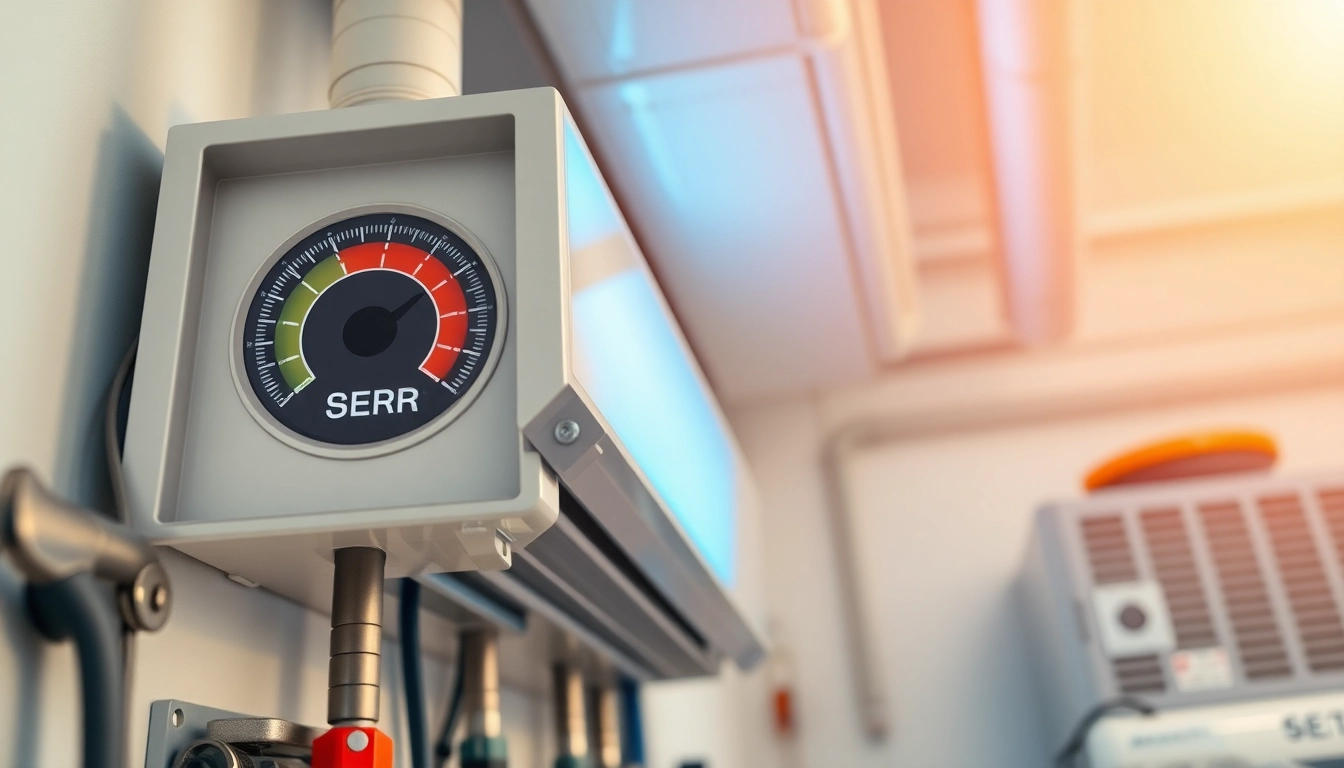
1. What Does SEER Stand For?
1.1 Definition of Seasonal Energy Efficiency Ratio
SEER stands for Seasonal Energy Efficiency Ratio. It is a crucial metric in the HVAC industry that measures the cooling output of an air conditioning system over a typical cooling season, divided by the total electric energy input during the same period. Specifically, the value is calculated in British Thermal Units (BTUs) over watt-hours, providing a numerical representation of how effectively an air conditioning unit converts electricity into cooling. A higher SEER rating signifies a more efficient air conditioning system, as it indicates more cooling output per unit of electrical input.
1.2 Importance of SEER in HVAC Systems
Understanding the hvac seer meaning is essential for homeowners and businesses looking to optimize their energy usage. SEER ratings not only indicate efficiency but also help in guiding consumers towards making informed decisions regarding their HVAC systems. Systems with higher SEER ratings can significantly reduce energy costs, which is increasingly important in today’s economy where energy prices are rising steadily.
1.3 Calculating SEER Ratings
The SEER rating of an HVAC system is determined through standardized testing that simulates various cooling conditions. According to the U.S. Department of Energy, the evaluation must cover various indoor and outdoor temperatures, resembling typical usage patterns. The formula for calculating SEER is:
SEER = Total BTUs of Cooling During the Season / Total Watt-Hours of Electricity Consumed During the Season
As a result, it is crucial for manufacturers to comply with established testing procedures to provide accurate SEER ratings that consumers can depend on when making purchases.
2. The Significance of HVAC SEER Ratings
2.1 How SEER Impacts Energy Efficiency
High SEER ratings directly correlate with energy efficiency. HVAC systems with higher ratings consume less electricity for the same cooling output compared to units with lower ratings. This increased efficiency not only translates into lower utility bills for consumers but also leads to less strain on grid resources, making high SEER systems a more sustainable choice overall.
2.2 SEER Ratings and Cost Savings
Investing in a higher SEER rated HVAC system may involve a higher upfront cost, but it is likely to yield significant long-term savings. According to the U.S. Department of Energy, upgrading from a 14 SEER to a 16 SEER unit can save a homeowner approximately 13% on cooling costs. The following factors should be considered when evaluating cost savings:
- Energy Prices: Local electricity rates will affect overall savings.
- Usage Patterns: The frequency and duration with which an AC unit is used.
- Home Insulation: Well-insulated homes retain cool air better, enhancing efficiency.
Homeowners should conduct a cost-benefit analysis to determine the potential savings versus the investment when selecting a unit.
2.3 Environmental Benefits of High SEER Units
In addition to financial advantages, investing in high SEER units generates environmental benefits. Increased energy efficiency reduces the overall carbon footprint associated with electricity generation, contributing to lower greenhouse gas emissions. As more consumers choose efficient systems, coupled with renewable energy sources, the cumulative effect can lead to a significant positive impact on the environment.
3. What Is a Good SEER Rating?
3.1 Average SEER Ratings Explained
As of 2024, the minimum SEER rating for newly installed central air conditioning systems is 14 in most regions of the U.S. However, good SEER ratings are typically regarded as:
- 14-16 SEER: Acceptable for many standard homes.
- 17-20 SEER: High efficiency, suitable for energy-conscious homeowners.
- 21+ SEER: Premium systems, ideal for high-demand users looking for maximum efficiency.
Consumers are encouraged to consider these average ratings as benchmarks when evaluating their needs.
3.2 Factors Influencing Ideal SEER Ratings
Several factors influence what constitutes an ideal SEER rating for a home:
- Geographic Location: Areas with hotter climates may benefit from higher SEER ratings due to increased usage.
- Home Size: Larger homes typically require systems with higher cooling capacities.
- Usage Patterns: Homes using air conditioning frequently benefit from higher efficiency ratings.
Consideration of these factors will allow homeowners to select the SEER rating that best fits their unique situation.
3.3 SEER Ratings by Region and Climate
Different regions in the United States have varying SEER requirements and the average ratings reflect regional climate demands:
- Southwest: Higher demand for cooling leads homeowners to favor units with SEER ratings between 16-20.
- Northeast: A focus on heating efficiency might yield preferred ratings of 14-16 due to variable climates.
- Pacific Coast: Milder temperatures result in average ratings around 14-16, with fewer high-efficiency units needed.
Injection of geographical awareness is vital for homeowners looking to optimize their HVAC efficiency.
4. How to Choose an HVAC System Based on SEER
4.1 Assessing Your Cooling Needs
Choosing the correct HVAC system starts with assessing your cooling requirements. Factors to consider include:
- Home Size: Larger homes require more substantial cooling systems.
- Insulation Quality: Proper insulation can reduce the size of system needed.
- Room Orientation: Sun exposure affects cooling requirements; south-facing rooms may need more cooling.
Performing a heat load calculation is recommended to determine the necessary cooling capacity accurately.
4.2 Comparing SEER Ratings of Different Models
When evaluating different HVAC models, focus on comparing SEER ratings along with other essential specifications. Look for:
- Warranty and support services from the manufacturer.
- Ratings from credible industry organizations and energy efficiency programs.
- Integrated technology options that can improve efficiency further.
This comprehensive approach ensures a well-rounded selection process for a new system.
4.3 Cost vs. Efficiency: Making the Right Decision
Deciding whether to prioritize cost or efficiency often hinges on personal circumstances:
- Budget Restrictions: Consider a balance between efficiency and affordability.
- Long-term Plans: Higher investments in efficiency yield better returns over time.
- Incentives: Federal and state tax credits may assist with the initial investment in higher SEER rated units.
Weighing the immediate costs against potential long-term savings is crucial in making a well-informed decision.
5. Frequently Asked Questions About SEER Meaning in HVAC
5.1 Common Misconceptions About SEER
SEER ratings are often misunderstood. Some common misconceptions include:
- Higher SEER means better performance in all situations: Efficiency varies based on specific cooling needs and environmental conditions.
- All HVAC systems are rated the same: The performance characteristics can differ significantly between manufacturers.
Understanding these misconceptions helps consumers make informed choices.
5.2 Upgrading Your HVAC System: Is It Worth It?
Upgrading an HVAC system can be beneficial, especially when considering energy efficiency. Assessing the age of your current system is crucial, as older units typically have lower SEER ratings. Experts recommend considering an upgrade if:
- Your system is over 10 years old.
- You’ve experienced increasing energy bills.
- Your system requires frequent repairs.
These indicators highlight not only the potential savings from an upgrade but also improvements in indoor comfort.
5.3 Long-Term Benefits of Higher SEER Ratings
Investing in a higher SEER rated HVAC system can yield numerous long-term benefits, such as:
- Lower Utility Bills: High SEER units reduce energy consumption, leading to significant savings annually.
- Extended System Lifespan: More efficient systems often require less operational strain, contributing to longevity.
- Increased Property Value: Homebuyers are increasingly looking for energy-efficient properties, enhancing resale potential.
Highlighting these benefits underscores the importance of selecting an adequately rated HVAC system tailored to individual needs.








